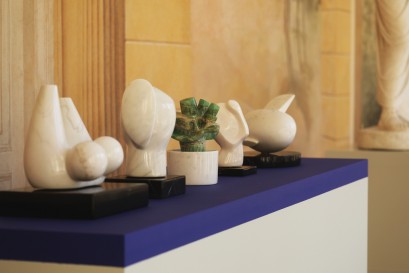‘I create happy art’, said Maria Papa Rostkowska, one of the most interesting sculptors of the 20th century, whose marble sculptures will be presented at a temporary exhibition at the Old Orangery from 9 September to 3 December 2023.
Maria Papa Rostkowska’s works will be on display at the Royal Sculpture Gallery and the Polish Sculpture Gallery from Tuesday to Wednesday from 10.00 to 16.00, on Thursday and Friday from 10.00 to 18.00, on Saturday from 12.00 to 18.00 and on Sunday from 10.00 to 16.00. The last entrance takes place 30 minutes before the closing of the exhibition. Admission with one combined ticket to the museum buildings: PLN 40 – normal ticket, PLN 20 – reduced ticket, PLN 1 – children over 7 years of age and youth up to 26 years, on Fridays – admission is free of charge.
‘Sculpture – the most complete art form’
The exhibition was created in collaboration with the family of Maria Papa Rostkowska and received the honorary patronage of the Italian Embassy and the French Embassy. The exhibition consists of 25 marble sculptures by the artist, including works such as ‘Big Angel’, ‘Gaia’, ‘The Unicorn’, ‘Bird of Happiness’ and ‘The Kiss’. One of them, which is made of white marble ‘The Promise of Happiness’ and which is to be exhibited as well, has been handed over to the Royal Łazienki Museum by the artist’s son, Nicolas Rostkowski.
Through the works on display, the sculptor addressed such important themes as: love, motherhood and bravery; she also evoked the symbolic figures of angel, warrior, bird, Pegasus and Venus. ‘Sculpture is the most complete art form for me. Contemporary, non-figurative sculpture makes us discover the reality that is within ourselves, which is different from copying nature,’ Maria Papa Rostkowska said.
Although formally her sculptures tend to be abstract and allusive, they remain specific and easy to read. Both the formal aspect and the content conveyed situate Maria Papa Rostkowska’s works in the tradition of classical sculpture, which transcends the boundaries of eras and formed the backbone of the eighteenth-century collection of Stanislaus Augustus. The juxtaposition of the artist’s works created in stone with royal plaster and marbles in the space of the Old Orangery provides an opportunity of a dialogue that takes place without historical and stylistic contexts. The craftsmanship of the sculptor can also be admired, with the main arguments being the material, the way it is finished and the relationship of the artistic form to the space.
‘The Promise of Happiness’ – events accompanying the exhibition
The exhibition of Maria Papa Rostkowska’s sculptures also features a rich programme of events for children, youth and adults. Join us for workshops and art meetings, natural science activities and guided tours of the exhibition.
Maria Papa Rostkowska (1923-2008), painter and designer by education, gained her creative fulfilment and international recognizability through sculpture. During the war, she studied at Jarzębowski School of Construction Drawing for Girls, named so for conspiration purposes while offering a rich education programme, including, among others, subjects such as design, drawing, graphics or architectural forms. In 1943, the painter married Ludwik Rostkowski, with whom she rescued Jews from the Warsaw ghetto during the occupation. As a soldier of polish army, she actively participated in the fights, for which she was awarded the Order of Virtuti Militari. In 1945, the only son of the couple, Mikołaj Zbigniew Rostkowski, was born. From 1950, the artist was professionally tied to the Academy of Fine Arts in Sopot and Warsaw, working as an assistant at the study of prof. Janusz Strzałecki. At that time, she participated in major collective exhibitions and art festivals in Poland, presenting mainly painted portraits (in the period of 1950-57). An important stage in the artist’s life began in 1957 when she moved to Paris and married Gualtieri Papa di San Lazzaro, a Sicilian writer, journalist, art critic and publisher of the art magazine "XXe Siècle". During their holidays in Albisoli in Italy, Maria Papa Rostkowska made her first attempts in ceramic sculpture; she crated plates and reliefs as well as abstract spatial forms. From then on, she fully devoted herself to sculpture. Starting from the late 50s, she experimented with terracotta and bronze castings and took part in numerous collective exhibitions in France and Italy. The first individual exhibition of the artist took place in 1961 in Galleria del Naviglio in Milan. A breakthrough in her work was the first piece made in stone in 1966. In the same year, thanks to the support of Hans Arp and Lucio Fontana, she won the prestigious prize of the William and Noma Copley Foundation. After that, she sculpted almost only in marble. She spent thirty years in Pietrasanta in Italy, near Carrara, which is known for deposits of high quality marble, where she worked in her study in Marbrerie Henraux. She sculpted directly in the material, so the final result of her work was determined by the creative process and not a precise initial model. The artist made both smaller pieces and monumental compositions presented in public space. Her sculptures were shown at about one hundred exhibitions in Europe (e.g. Parisian salons, Ravenna, Milan, Warsaw) and abroad (Japan). In total, Maria Papa Rostkowska created over 300 stone pieces. Some of them are now part of museum and private collections throughout the world, among others in Poland, Switzerland, United States, France and Italy.
